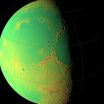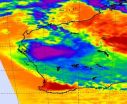(Press-News.org) Like a fence or barricade intended to stop unwanted intruders, the skin serves as a barrier protecting the body from the hundreds of allergens, irritants, pollutants and microbes people come in contact with every day. In patients with eczema, or atopic dermatitis, the most common inflammatory human skin disease, the skin barrier is leaky, allowing intruders – pollen, mold, pet dander, dust mites and others – to be sensed by the skin and subsequently wreak havoc on the immune system.
While the upper-most layer of the skin – the stratum corneum – has been pinned as the culprit in previous research, a new study published today in the Journal of Allergy and Clinical Immunology found that a second skin barrier structure, consisting of cell-to-cell connections known as tight junctions, is also faulty in eczema patients and likely plays a role in the development of the disease. Tightening both leaky barriers may be an effective treatment strategy for eczema patients, who often have limited options to temper the disease.
"Over the past five years, disruption of the skin barrier has become a central hypothesis to explain the development of eczema," said Lisa Beck, M.D., lead study author and associate professor in the Department of Dermatology at the University of Rochester Medical Center. "Our findings challenge the belief that the top layer of the skin or stratum corneum is the sole barrier structure: It suggests that both the stratum corneum and tight junctions need to be defective to jumpstart the disease."
Currently, there are no treatments that target skin barrier dysfunction in eczema. To treat eczema, which causes dry, red, itchy skin, physicians typically prescribe anti-inflammatory drugs, like prednisone, and a variety of topical anti-inflammatory creams and ointments. But, modest benefit, negative side effects and cost concerns associated with these therapies leave patients and doctors eagerly awaiting new alternatives.
"We want to figure out what current eczema therapies do to both barrier structures and start thinking about new treatments to close the breaks that let irritants in and water out and subsequently drive the inflammation and dryness that is characteristic of the disease," noted Beck, who treats eczema patients in addition to conducting research on the condition.
To better understand the role of tight junctions in eczema, Beck and her team studied skin samples from eczema patients and healthy individuals. Using resistance and permeability tests, they discovered that tight junctions, which act like a gate controlling the passage of water and particles, were strong and tight in healthy skin samples, yet loose and porous in the skin of eczema patients.
On further investigation, they found that a particular tight junction protein, claudin-1, which determines the strength and permeability of tight junctions in skin, is significantly reduced in the skin of eczema patients, but not in healthy individuals or individuals with psoriasis, another common chronic skin disease. They demonstrated that reducing claudin-1 expression in skin cells from healthy donors made the tight junctions leaky and more permeable, a finding in line with results of other research groups.
"Since claudin-1 was only reduced in eczema patients, and not the other controls, it may prove to be a new susceptibility gene in this disease," said Anna De Benedetto, M.D., postdoctoral-fellow at the Medical Center and first author of the new study. "Our hypothesis is that reduced claudin-1 may enhance the reactivity to environmental antigens and lead to greater allergen sensitization and susceptibility in people with eczema."
If the team's hypothesis stands up in future research, increasing claudin-1 to combat eczema could be a new treatment approach worth exploring. The University of Rochester has applied for patent protection for increasing claudin-1 with drug compounds to treat eczema.
Barrier problems, and in particular tight junction defects, are recognized as a common feature in many other inflammatory diseases, such as inflammatory bowel disease and asthma, where the lining of the intestine and the airways is weakened, which is why Beck and her team decided to focus on the role of this barrier structure in eczema.
Eczema affects up to 17 percent of children and about six percent of adults in the United States – close to 15 million Americans. While there are varying severities of eczema, all have an itch that can make it difficult to focus on daily activities and to sleep. People with eczema are often counseled to minimize their exposure to allergens, but that is a difficult task given the hundreds of allergens people are exposed to each day.
Beck, who began the research while at Johns Hopkins University, plans to build on these findings by investigating the immunologic consequences of tight junction disruption in the skin and whether there is a relationship between barrier disruption and subjects' intractable itch. In addition, as part of a contract with the National Institute of Allergy and Infectious Diseases (NIAID) at the National Institutes of Health, called the Atopic Dermatitis Research Network, Beck, in collaboration with Kathleen Barnes, Ph.D., at Johns Hopkins, will perform gene mapping of claudin-1 to try to identify mutations in patients with eczema.
INFORMATION:
The current research was funded by the Atopic Dermatitis and Vaccinia Network at NIAID, the National Eczema Association and the Mary Beryl Patch Turnbull Scholar Program. Along with Beck and De Benedetto, Andrei I. Ivanov, Ph.D., Steve N. Georas, M.D., Kunzhong Zhang, Ph.D., Sadasivan Vidyasagar, M.D., Ph.D., and Takeshi Yoshida, Ph.D., from the University of Rochester Medical Center participated in the research. Scientists from Johns Hopkins University School of Medicine, National Jewish Health, the University of California, San Diego, Children's Hospital Boston, Oregon Health & Science University, the University of Bonn (Germany), Technische Universität München (Germany) and Johns Hopkins Bloomberg School of Public Health contributed as well.
Study reveals major shift in how eczema develops
Not 1, but 2 skin barriers influential in most common skin disease
2010-12-18
ELSE PRESS RELEASES FROM THIS DATE:
Ancient raindrops reveal a wave of mountains sent south by sinking Farallon plate
2010-12-18
50 million years ago, mountains began popping up in southern British Columbia. Over the next 22 million years, a wave of mountain building swept (geologically speaking) down western North America as far south as Mexico and as far east as Nebraska, according to Stanford geochemists. Their findings help put to rest the idea that the mountains mostly developed from a vast, Tibet-like plateau that rose up across most of the western U.S. roughly simultaneously and then subsequently collapsed and eroded into what we see today.
The data providing the insight into the mountains ...
Computer games and science learning
2010-12-18
Computer games and simulations are worthy of future investment and investigation as a way to improve science learning, says LEARNING SCIENCE: COMPUTER GAMES, SIMULATIONS, AND EDUCATION, a new report from the National Research Council. The study committee found promising evidence that simulations can advance conceptual understanding of science, as well as moderate evidence that they can motivate students for science learning. Research on the effectiveness of games designed for science learning is emerging, but remains inconclusive, the report says.###
The report is available ...
You only live once: our flawed understanding of risk helps drive financial market instability
2010-12-18
Our flawed understanding of how decisions in the present restrict our options in the future means that we may underestimate the risk associated with investment decisions, according to new research by Dr Ole Peters from Imperial College London. The research, published today in the journal Quantitative Finance, suggests how policy makers might reshape financial risk controls to reduce market instability and the risk of market collapse.
Investors know that there are myriad possibilities for how a financial market might develop. Before making an investment, they try to capture ...
Efficient phosphorus use by phytoplankton
2010-12-18
Rapid turnover and remodelling of lipid membranes could help phytoplankton cope with nutrient scarcity in the open ocean.
A team led by Patrick Martin of the National Oceanography Centre has shown that a species of planktonic marine alga can rapidly change the chemical composition of its cell membranes in response to changes in nutrient supply. The findings indicate that the process may be important for nutrient cycling and the population dynamics of phytoplankton in the open ocean.
Tiny free-floating algae called phytoplankton exist in vast numbers in the upper ocean. ...
Effect of college on volunteering greatest among disadvantaged college graduates
2010-12-18
Sociologists have long known that a college education improves the chances that an individual will volunteer as an adult. Less clear is whether everyone who goes to college gets the same boost in civic engagement from the experience.
In an innovative study that compared the volunteering rates of college graduates with those of non–college graduates with similar social backgrounds and high school achievement levels, UCLA sociologist Jennie Brand found something striking: A college education has a much greater impact on volunteering rates among individuals from underprivileged ...
Ion channel responsible for pain identified by UB neuroscientists
2010-12-18
BUFFALO, N.Y. -- University at Buffalo neuroscience researchers conducting basic research on ion channels have demonstrated a process that could have a profound therapeutic impact on pain.
Targeting these ion channels pharmacologically would offer effective pain relief without generating the side effects of typical painkilling drugs, according to their paper, published in a recent issue of The Journal of Neuroscience.
"Pain is the most common symptom of injuries and diseases, and pain remains the primary reason a person visits the doctor," says Arin Bhattacharjee, PhD, ...
A total lunar eclipse and winter solstice coincide on Dec. 21
2010-12-18
With frigid temperatures already blanketing much of the United States, the arrival of the winter solstice on December 21 may not be an occasion many people feel like celebrating. But a dazzling total lunar eclipse to start the day might just raise a few chilled spirits.
Early in the morning on December 21 a total lunar eclipse will be visible to sky watchers across North America (for observers in western states the eclipse actually begins late in the evening of December 20), Greenland and Iceland. Viewers in Western Europe will be able to see the beginning stages of ...
NASA's LRO creating unprecedented topographic map of moon
2010-12-18
NASA's Lunar Reconnaissance Orbiter is allowing researchers to create the most precise and complete map to date of the moon's complex, heavily cratered landscape.
"This dataset is being used to make digital elevation and terrain maps that will be a fundamental reference for future scientific and human exploration missions to the moon," said Dr. Gregory Neumann of NASA's Goddard Space Flight Center in Greenbelt, Md. "After about one year taking data, we already have nearly 3 billion data points from the Lunar Orbiter Laser Altimeter on board the LRO spacecraft, with near-uniform ...
NASA satellite tracks soaking System 91S in western Australia
2010-12-18
NASA's Aqua satellite captured a series of images from its Atmospheric Infrared Sounder (AIRS) instrument over the last two days and saw the low pressure area known as System 91S make landfall in Australia. System 91S may not have become a tropical depression, but it's dropping heavy rainfall in Western Australia.
NASA's AIRS infrared instrument showed System 91S's center making landfall on Dec. 16 at 0647 UTC (1:47 a.m. EST) near the town of Carnavon in Western Australia. At that time, there was a large area of strong thunderstorms around the center of circulation, ...
New Article On OffTheGridNews.com Points to Some Challenging Questions; is Outrage Over WikiLeaks Revelations Misguided?
2010-12-18
The controversy surrounding whistle-blowing website WikiLeaks along with its creator Julian Assange continues to gain momentum as liberal Democrats and conservative Republicans have joined together in one voice to condemn the most recent leaks that Senator Diane Feinstein has described as "a serious breach of national security and could be used to severely harm the United States and its worldwide interests."
If you're looking to score popularity points in Washington now is the time to jump on the anti-Assange bandwagon and condemn the Aussie for his complicity in weakening ...
LAST 30 PRESS RELEASES:
Discovery on how aggressive breast cancer controls protein production
A simple blood test can predict Crohn’s disease years before symptoms appear
FAU study reveals social, family and health factors behind teen bullying
New alliance trial seeks to reduce delays in gastrointestinal cancer treatment
Discovery of a new superfluid phase in non-Hermitian quantum systems
Codes in the cilia: New study maps how Cilk1 and Hedgehog levels sculpt tooth architecture
Chonnam National University researchers develop novel virtual sensor grid method for low-cost, yet robust, infrastructure monitoring
Expanded school-based program linked to lower youth tobacco use rates in California
TV depictions of Hands-Only CPR are often misleading
What TV gets wrong about CPR—and why it matters for saving lives
New study: How weight loss benefits the health of your fat tissue
Astronomers surprised by mysterious shock wave around dead star
‘Death by a thousand cuts’: Young galaxy ran out of fuel as black hole choked off supplies
Glow with the flow: Implanted 'living skin' lights up to signal health changes
Compressed data technique enables pangenomics at scale
How brain waves shape our sense of self
Whole-genome sequencing may optimize PARP inhibitor use
Like alcohol units, but for cannabis – experts define safer limits
DNA testing of colorectal polyps improves insight into hereditary risks
Researchers uncover axonal protein synthesis defect in ALS
Why are men more likely to develop multiple myeloma than women?
Smartphone-based interventions show promise for reducing alcohol and cannabis use: New research
How do health care professionals determine eligibility for MAiD?
Microplastics detected in rural woodland
JULAC and Taylor & Francis sign open access agreement to boost the impact of Hong Kong research
Protecting older male athletes’ heart health
KAIST proposes AI-driven strategy to solve long-standing mystery of gene function
Eye for trouble: Automated counting for chromosome issues under the microscope
The vast majority of US rivers lack any protections from human activities, new research finds
Ultrasound-responsive in situ antigen "nanocatchers" open a new paradigm for personalized tumor immunotherapy
[Press-News.org] Study reveals major shift in how eczema developsNot 1, but 2 skin barriers influential in most common skin disease



